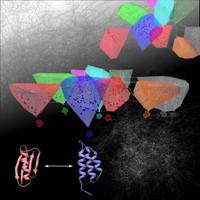 How might new protein folds evolve without detrimental
effects on the biological function performed by the existing native folded structure? Because a protein's conformational
ensemble encompasses all possible conformations---not only the native fold,
selection of "latent", "promiscuous" traits encoded by
nonnative conformations while the
original function is largely preserved can be an efficient route to new function. The "adaptive
conflict" between the old fold and the new fold can then be resolved by gene duplication.
It should be noted, however, that not
all proteins function as folded structures.
How might new protein folds evolve without detrimental
effects on the biological function performed by the existing native folded structure? Because a protein's conformational
ensemble encompasses all possible conformations---not only the native fold,
selection of "latent", "promiscuous" traits encoded by
nonnative conformations while the
original function is largely preserved can be an efficient route to new function. The "adaptive
conflict" between the old fold and the new fold can then be resolved by gene duplication.
It should be noted, however, that not
all proteins function as folded structures.
Intrinsically disordered proteins (IDPs) also perform critical functions. Remarkably, some IDPs function collectively by undergoing liquid-liquid phase separation in and around living cells. The resulting high-IDP phases create their own IDP-rich compartments, such as the nucleolus, to provide specific stimuli for critical biological functions. To gain physical insights into these fascinating phenomena, I will discuss our recent efforts in using simple computational models and analytical theory to elucidate how new protein folds might have arisen in evolution and how biologically functional IDP phase separation is governed by their genetically-coded amino acid sequences.

